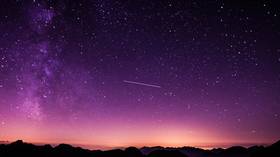Comet me, bro! What are your chances of finding a crashed meteorite on Earth?

It seems that every other week there’s news of a close flyby by an asteroid or meteor shower, but what are the average person’s chances of getting in on the action and actually finding one? We find out.
An average of one small asteroid per year hits the Earth, but during the same time there are approximately 500 meteorite impacts. A meteorite is a meteoroid, or solid piece of debris from outer space, that somehow manages to survive entry into our atmosphere.
Also on rt.com Spectacular meteor shower set to light up skies tonight: What you need to knowYour chances
An area the size of the average American home (2,500 sq ft) has a 1 in 2,196,267,379,587 chance of being struck by a single asteroid, but with meteorites the odds improve substantially, given that there are roughly 500 each year, to somewhere in the region of 1 in 4,392,536,564, according to US real estate company Movoto.
The firm came to this conclusion by comparing the Earth’s land surface area of roughly 150,000,000 sq km, and comparing that to an average-sized home.
You can check your chances using their handy calculator here.
As you can see, the odds are infinitesimally small.
For reference, in the US your odds of being struck by lightning in a given year are 1 in 700,000; during an 80-year lifespan the odds narrow to 1 in 3,000.
That’s not to say it doesn’t happen though. Oftentimes, meteorites slam into earth and go unnoticed by oblivious landowners. Consider the case of Michigan man David Mazurek, who bought a barn from a farmer in 1988, only for the farmer to include a ‘meteorite’ to sweeten the deal. Mazurek thought nothing of the 22-pound rock, and used it as a doorstop for 30 years, but brought it to the University of Michigan for analysis when curiosity got the better of him last year. Lo and behold, Mazurek’s rock was a bona fide meteorite, and is potentially worth $100,000.
Ann Hodges had an even closer encounter with outer space. Napping on her couch in Sylacauga, Alabama, in 1954, Hodges was awoken when a nine-pound meteorite smashed through her ceiling and bounced off her thigh. Local farmers also found shattered pieces of ‘Hodge’s Meteorite’ in their fields.
What to look for
As the US Department of Earth and Planetary Sciences explains in painstaking detail, even if you do fancy your chances of finding a meteorite, it is extremely difficult to identify one among the ordinary rocks. The process would be similar to trying to find a rare needle in an almost unfathomably large pile of similar needles.
Also on rt.com Four asteroids on COLLISION course with Earth‘Meteorite hunter’ Geoffrey Notkin is more optimistic, in the way that celebrity Science Channel hosts tend to be. Notkin recommends passing a strong magnet over suspicious rocks, as meteorites tend to be rich in iron. Many earth rocks will also attract a magnet, he notes, “so this is not a definitive test, but it's a good step in the right direction.”
Furthermore, meteorites will usually be heavier than the surrounding rocks, and darker due to the surface melt that occurs when they streak through our atmosphere.
Looking closer, aspiring meteorite hunters should keep their eyes peeled for hair-thin ‘flow lines’ on the meteorite’s surface, caused as the space-chunk melts while hurtling to earth. If you’re certain you’re on to a winner, break out the power tools and angle-grind a corner off your rock. Miniscule metallic flakes and spherical inclusions inside are a dead giveaway that you’re dealing with a meteorite.
Where to look
If you’re really determined to get your hands on some space rock places like the Nullarbor Plain in Australia (with an area of approximately 200,000 square kilometers) are known for their extensive meteorite deposits. This is often due to extremely arid climates, where weather conditions leave space rocks on the surface, and in the Nullarbor Plain’s case, neatly presented on top of the area’s vast limestone bedrock.
However, the plain boasts average daytime temperatures of 50 degrees Celsius (122 Fahrenheit) and nightly temperatures below freezing, so good luck to any budding meteorite hunters hoping to locate the long-rumored ‘car-sized meteorite’ in the expansive plain.
Like this story? Share it with a friend!














